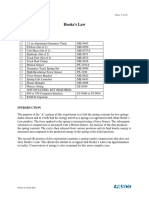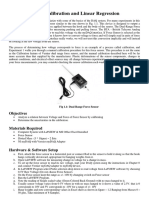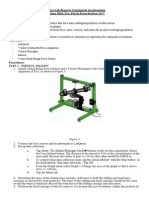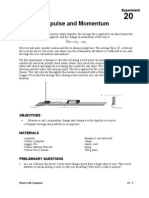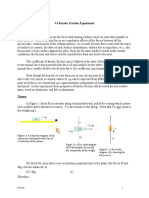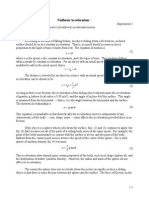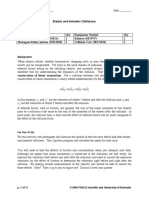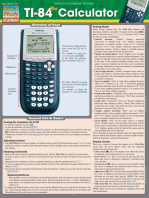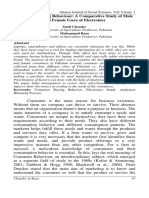Coefficients of Friction
Coefficients of Friction
Uploaded by
hammygoraya2226Copyright:
Available Formats
Coefficients of Friction
Coefficients of Friction
Uploaded by
hammygoraya2226Copyright
Available Formats
Share this document
Did you find this document useful?
Is this content inappropriate?
Copyright:
Available Formats
Coefficients of Friction
Coefficients of Friction
Uploaded by
hammygoraya2226Copyright:
Available Formats
23 Coefficients of Friction 23 - Page 1 of 6
Coefficients of Friction
Equipment:
1 Motion Sensor PS-2103A
1 Force Sensor PS-2189
1 Dynamics System ME-6955
1 Discover Friction ME-8574
1 Motorized Cart ME-9781
2 Compact Mass ME-6755
1 Braided String SE-8050
Required, but not included:
1 Balance SE-8723
Introduction
The Friction Trays have different materials on their bottom surface. The Motorized Cart (see Fig.
1) is used to pull the trays in a controlled manner along the track, as the Force Sensor directly
measures the frictional force. All parameters are investigated, including speed, normal force, and
surface area.
Figure 1: Measuring Sliding Friction
Setup
1. Set up the track as shown in Figure 1, and use the adjustable feet to level the track.
2. Connect the Motion Sensor to the PASPORT input P1, and attach it to the track. Make
sure the switch on the top of the Motion Sensor is set to “cart”.
Written by Jon Hanks
23 Coefficients of Friction 23 - Page 2 of 6
3. Connect the Force Sensor to the PASPORT input P4. Using the long thumbscrew, attach
the Force Sensor to the cart as shown in Figure 2. Place the Cart/Force Sensor assembly
on the track. Change the sample rate to 10 Hz. Open the properties for the Force Sensor
in the Data Summary and check the Change Sign box.
4. Connect the Motorized Cart power cord to Output #1, and make sure the cart is on the
OFF/EXTERNAL setting. With the DC Voltage set to 2 volts, turn the output on and off
to ensure that the cart is working. You can open and close the output window by clicking
on the Signal Generator icon in the tool palette.
5. Connect the Friction Trays to the Force Sensor using string as shown in Figure 2. The
lower tray should have the black felt surface. You must always pull with two carts
stacked, so that the Force Sensor pulls level. For the top tray, use one of the trays with the
white plastic on the bottom. The lower end of the string is just looped around the tray
hook: This makes it easier to swap out the lower tray to change the surface.
6. Place both silver cart masses in the upper friction tray. If the Motorized Cart has trouble
pulling the load, add the black Compact Masses to the cart in front of the Force Sensor. If
you still have trouble, remove one of the silver masses from the tray.
Figure 2: Towing the Friction Carts
7. Make a graph of velocity vs. time and add a plot area and put force in the second plot
area. Select a Quick-Calc for the velocity (-v) to change the sign of the velocity so it will
be positive.
Written by Jon Hanks
23 Coefficients of Friction 23 - Page 3 of 6
Procedure: Measuring Speed and Force
1. Position the cart and trays at the far end of the track, opposite the motion sensor. This is
the starting position for all the runs.
2. Open the Signal Generator window, and set the voltage for 1.0 volt DC. The output
should be set on Auto, which will automatically turn on the cart when you start recording
data, and stop the cart when data collection is ended.
3. Click on Record. Stop recording before the cart hits the motion sensor.
4. If the Motorized Cart can't pull the load, increase the voltage to 1.5 volts.
5. Adjust the Motion Sensor if necessary to get good velocity data.
6. The force data will be noisy, but you will be able to get an average reading. Try using the
Smoothing tool in the Graph tool palette.
Changing Speed:
1. Change the sample rate of all the sensors to a common rate of 20 Hz.
2. Create a table with three columns: In the first column, create a User-Entered data set
called Voltage (units of V); In the second column, create a Run-Tracked User-Entered
data set called Speed (units of cm/s) ); In the third column, create a Run-Tracked User-
Entered data set called Friction (units of N).
3. Use the Coordinates tool to measure the speed and the frictional force. Pick a time that
has reasonably good data for both.
4. Record your values in the table.
5. Repeat for voltages of 1.5 V, 2.0 V, 2.5 V, etc. up to 5.0 volts.
6. Create a graph of Friction vs. Speed. What trend can you see in the data? How does the
frictional force depend on the speed?
7. Take the ratio of the fastest speed/ slowest speed. By what factor did you vary the speed?
By what factor did the resulting frictional force change? Would you say that the friction
changed a little or a lot?
8. Does your data support the concept that it is a useful approximation to assume that
sliding friction is independent of speed?
Written by Jon Hanks
23 Coefficients of Friction 23 - Page 4 of 6
Changing Normal Force:
1. Create a table with four columns: In the first column, create a Run-Tracked User-Entered
data set called Tray (unitless); In the second column, create a User-Entered data set called
Mass (units of g); In the third column, create a calculation (units of N)
Normal Force₁ = [Mass (g)]*9.8/1000
In the fourth column, select Friction.
2. Replace the lower felt tray with a tray that has a white plastic surface. Start with both
trays empty, and use the balance to determine the mass. Calculate the combined weight,
and enter this as the normal force in the table below.
3. Set the voltage output to 1.5 volts. Click on Record. Stop recording before the cart hits
the motion sensor.
4. Using the graph, note the approximate speed and, if necessary, adjust the voltage in later
runs to keep the speed the same.
5. Record the frictional force in the table. Add the 4 mass bars (one at a time) and repeat.
You should end up with 5 values.
6. Create a graph of Friction vs. Normal Force1. What trend can you see in the data? Try a
linear Curve Fit. Is your data linear?
7. Most text books make the assumption that
f = μN (1)
where f = friction, N= normal force, and μ = the frictional coefficient. Does your data
support this assumption? What are the units for μ?
Written by Jon Hanks
23 Coefficients of Friction 23 - Page 5 of 6
Changing Surface Material:
1. Create a table with four columns: In the first column, create a User-Entered data set
called Cart Material (unitless); In the second column, create a User-Entered data set
called Normal Force (units of N); In the third column, create a User-Entered data set
called Frictional Force (units of N); In the fourth column, create a calculation (unitless)
μ = [Frictional Force (N)]/[Normal Force (N)]
2. Remove all but one of the mass bars. Click on Record, and use the graph to measure the
frictional force.
3. Coefficients are always between two surfaces. What is the other surface?
4. Replace the lower plastic tray with a tray with black felt and repeat. Replace the lower
felt tray with a tray with brown cork material and repeat.
5. Which material has the largest coefficient? Which has the least?
6. What type of friction are you measuring: Static or Sliding (Kinetic) friction?
Changing Area:
1. Connect the trays as shown in Figure 3. The bottom two trays should both be the white
plastic. Place one of the silver mass bars in each of the two upper trays, and perform the
pull test as before.
2. Measure the force from the graph and use equation (1) to calculate the coefficient of
friction for the white plastic material.
3. How does this value (with twice the surface area) compare to your previous values? Most
text books assume that sliding friction is independent of surface area. Do you agree?
Figure 3: Changing Surface Area
Written by Jon Hanks
23 Coefficients of Friction 23 - Page 6 of 6
Static Friction:
1. Increase the sample rate of the force sensor to 2 kHz (the maximum).
2. On the graph, change the negative velocity to the Position.
3. Remove the trailing two trays, returning to the original set-up pulling only two trays. The
lower tray should be cork. Place both silver masses in the upper tray, and both black
masses on the Motorized Cart in front of the Force Sensor. If the cart won't pull the trays,
remove one of the silver masses.
4. The Signal Generator is now set to ramp up its voltage, to slowly increase the pulling
force over a 10 second period. If the trays don't break free and move in that time, increase
the voltage amplitude.
5. Click on Record. As soon as the tray starts to slide, click on stop.
6. Examine your data on the graph. You can see from the position data where the tray starts
to slide, and the value of the sliding friction force after this point. In the time before this,
what does the force data look like?
7. Most materials show a value for static friction slightly larger than for sliding (kinetic)
friction. Does your data support this? What is your largest value for the Static
coefficient?
Written by Jon Hanks
You might also like
- Static and Kinetic Friction: ComputerDocument6 pagesStatic and Kinetic Friction: ComputerbobpleaseNo ratings yet
- 19 Impulse and Momentum LQ - ModifiedDocument6 pages19 Impulse and Momentum LQ - ModifiedRaymond Zheng100% (1)
- Its All UphillDocument2 pagesIts All Uphillmelissa0% (1)
- GRI 200-36 Data SheetDocument3 pagesGRI 200-36 Data SheetJMAC SupplyNo ratings yet
- Newton's Second Law: EquipmentDocument6 pagesNewton's Second Law: EquipmentSerena FengNo ratings yet
- Coefficient of Kinetic Friction and Drag ForceDocument7 pagesCoefficient of Kinetic Friction and Drag ForcejhhjjhNo ratings yet
- 33 Collisions in 1DDocument4 pages33 Collisions in 1DdiagohuidobroooNo ratings yet
- EX-5513A Work Energy TheoremDocument6 pagesEX-5513A Work Energy TheoremIvan Perez VivancoNo ratings yet
- 09 Static and Kinetic FrictionDocument6 pages09 Static and Kinetic FrictionWanda AstariNo ratings yet
- Static & Kinetic Friction ExprementDocument7 pagesStatic & Kinetic Friction ExprementBishoy GirgisNo ratings yet
- LAB 1 Newton 2nd Law - 2018Document8 pagesLAB 1 Newton 2nd Law - 2018afif danialNo ratings yet
- Spring Thing: Newton's Second Law: ActivityDocument7 pagesSpring Thing: Newton's Second Law: Activitylolapoppyjane23No ratings yet
- Lesson 08 Acceleration RPDocument15 pagesLesson 08 Acceleration RPAlya Defa AnindaNo ratings yet
- Lab 04 BDocument4 pagesLab 04 Bthapasamee621No ratings yet
- Day 4 - Lab - Newton's 2nd Law v.2Document2 pagesDay 4 - Lab - Newton's 2nd Law v.2johnNo ratings yet
- Rotational Dynamics LabDocument6 pagesRotational Dynamics LabMuzaher Ali KhanNo ratings yet
- UPM Lab Manual B-TECHDocument20 pagesUPM Lab Manual B-TECHBismit MaharanaNo ratings yet
- Basic Kinematics: Physics 151/161Document6 pagesBasic Kinematics: Physics 151/161Kamila FaizrakhmanNo ratings yet
- 12 Static Friction LAb 6Document6 pages12 Static Friction LAb 6Nemo SecretNo ratings yet
- Experiment 1Document5 pagesExperiment 1Sarah Kaye GaleroNo ratings yet
- Atwood's MachineDocument22 pagesAtwood's MachineagnesNo ratings yet
- Experiment: Atwood Machine: ObjectivesDocument4 pagesExperiment: Atwood Machine: ObjectivessygexNo ratings yet
- Laboratory Activity 6 Force Mass Motion 1Document6 pagesLaboratory Activity 6 Force Mass Motion 1fakhrizal2018No ratings yet
- 04 AP1 Coefficients of Friction SDocument6 pages04 AP1 Coefficients of Friction STrần Bích NgọcNo ratings yet
- 29 Rotational Kinetic EnergyDocument4 pages29 Rotational Kinetic Energymuzahir.ali.baloch2021No ratings yet
- Elastic Properties of Solids - ManualDocument9 pagesElastic Properties of Solids - ManualMuzamil ShahNo ratings yet
- Experiment 6 The Coefficient of Friction: EquipmentDocument3 pagesExperiment 6 The Coefficient of Friction: Equipment1DaddictNo ratings yet
- UPM Lab ManualDocument19 pagesUPM Lab Manualrohitanurag0317No ratings yet
- Hooke's Law: EquipmentDocument12 pagesHooke's Law: EquipmentTria Wury AnjaniNo ratings yet
- Static and Kinetic FrictionDocument7 pagesStatic and Kinetic FrictionVikash SinghNo ratings yet
- Movimiento Armonico SimpleDocument6 pagesMovimiento Armonico SimpleFrancisco Manuel Ugarte PalacinNo ratings yet
- TP11 ImpulseDocument11 pagesTP11 Impulsebd87glNo ratings yet
- E15 Newtons 2nd LawDocument5 pagesE15 Newtons 2nd LawVei AdoptanteNo ratings yet
- Lab Manual - Newtons 2nd LawDocument6 pagesLab Manual - Newtons 2nd Lawikitan20050850No ratings yet
- Lab 4 Newtons First LawDocument4 pagesLab 4 Newtons First LawAndrew GomezNo ratings yet
- Newton Second LawDocument4 pagesNewton Second LawLester ParadilloNo ratings yet
- UPM Lab Manual 29.07.15 RevisedDocument19 pagesUPM Lab Manual 29.07.15 RevisedAbhisikta MishraNo ratings yet
- Friction Lab Question: What Factors Affect The Force of Friction?Document3 pagesFriction Lab Question: What Factors Affect The Force of Friction?Ava SerieNo ratings yet
- 6 SPH3U PHET FBD and Newton's Laws With Friction Virtual LabDocument5 pages6 SPH3U PHET FBD and Newton's Laws With Friction Virtual Lablim05abcNo ratings yet
- Atwood's Machine2Document5 pagesAtwood's Machine2miyang0788No ratings yet
- Lab Report Cen Force - 1Document5 pagesLab Report Cen Force - 1api-257247956No ratings yet
- 114 M3 LabReportDocument10 pages114 M3 LabReportflamingocafe41No ratings yet
- Lab Manual - Magnetic Field of A Single CoilDocument7 pagesLab Manual - Magnetic Field of A Single CoilManu ThomasNo ratings yet
- Physics Lab Report - Centripetal AccelerationDocument4 pagesPhysics Lab Report - Centripetal Accelerationapi-257066694No ratings yet
- Lab 10 ImpulseDocument4 pagesLab 10 ImpulseAndrew Gomez0% (1)
- Atwood's MachineDocument22 pagesAtwood's MachineDebora Tresia PurbaNo ratings yet
- 20 Impulse and MomentumDocument5 pages20 Impulse and MomentumRyan SheridanNo ratings yet
- Work and Energy: Driving QuestionsDocument9 pagesWork and Energy: Driving QuestionsdermaNo ratings yet
- # 6 Kinetic Friction Experiment DiscussionDocument4 pages# 6 Kinetic Friction Experiment DiscussionTauQeer ShahNo ratings yet
- Conservation of Momentum and Energy LabDocument4 pagesConservation of Momentum and Energy LabJohn DavisNo ratings yet
- Uniform Acceleration: Objective: To Study The Kinematics of Uniformly Accelerated Motion. DiscussionDocument6 pagesUniform Acceleration: Objective: To Study The Kinematics of Uniformly Accelerated Motion. DiscussionAlfred LacandulaNo ratings yet
- M V V V V: Name - DateDocument11 pagesM V V V V: Name - Datek tNo ratings yet
- 12/1: PASCO Newton's 2nd Law Lab: Tuesday, October 27, 2020 6:45 AMDocument4 pages12/1: PASCO Newton's 2nd Law Lab: Tuesday, October 27, 2020 6:45 AMTanisha BhatiaNo ratings yet
- Paul FrictionDocument5 pagesPaul FrictionPaul Aldrin OlvezNo ratings yet
- A-level Physics Revision: Cheeky Revision ShortcutsFrom EverandA-level Physics Revision: Cheeky Revision ShortcutsRating: 3 out of 5 stars3/5 (10)
- Method of Moments for 2D Scattering Problems: Basic Concepts and ApplicationsFrom EverandMethod of Moments for 2D Scattering Problems: Basic Concepts and ApplicationsNo ratings yet
- Maya Visual Effects The Innovator's Guide: Autodesk Official PressFrom EverandMaya Visual Effects The Innovator's Guide: Autodesk Official PressNo ratings yet
- The Metamorphoses of OvidVol. I, Books I-VII by Naso, Publius OvidiusDocument18 pagesThe Metamorphoses of OvidVol. I, Books I-VII by Naso, Publius OvidiusGutenberg.orgNo ratings yet
- EN CREA - CELIOS Indonesia Nickel Development 2024Document105 pagesEN CREA - CELIOS Indonesia Nickel Development 2024Mas RioNo ratings yet
- Lessen A2Document10 pagesLessen A2hanitriniainambolatina08No ratings yet
- Module On Town Planning SchemesDocument6 pagesModule On Town Planning Schemesritesh MishraNo ratings yet
- Mba 3 Sem Web Technology and e Commerce Kmbit02 2020Document2 pagesMba 3 Sem Web Technology and e Commerce Kmbit02 2020tushaar B'ramaniNo ratings yet
- Jeppview For Windows: List of Pages in This Trip KitDocument68 pagesJeppview For Windows: List of Pages in This Trip KitАртемий ПетровNo ratings yet
- Computer Systems Servicing Daily Lesson LogDocument56 pagesComputer Systems Servicing Daily Lesson LogLeo Arjona Tuplano Jr.No ratings yet
- Qed BatonDocument25 pagesQed BatonKedarNo ratings yet
- Practical Research 2 First Quarter ExamDocument4 pagesPractical Research 2 First Quarter Examwencylle casilNo ratings yet
- Consumer Buying Behaviour A Comparative Study of Male and Female Users of ElectronicsDocument15 pagesConsumer Buying Behaviour A Comparative Study of Male and Female Users of ElectronicsAshfaqur019No ratings yet
- History Copy RightDocument13 pagesHistory Copy RightClaudine ArrabisNo ratings yet
- Godrej Presentation FinalDocument21 pagesGodrej Presentation FinalAkshay MunotNo ratings yet
- Mediation Techniques (Mediating in Courts)Document54 pagesMediation Techniques (Mediating in Courts)joan mziNo ratings yet
- Aircel Telecom LTD - Health & Safety - Employee HandbookDocument163 pagesAircel Telecom LTD - Health & Safety - Employee Handbookmohit.shahane.msNo ratings yet
- Lumileds Demo LED Bulbs and Modules LeafletDocument2 pagesLumileds Demo LED Bulbs and Modules LeafletAkbar ZuhriNo ratings yet
- Promet U ManualDocument48 pagesPromet U Manualmrnoboby0407No ratings yet
- Beginner's Guide: Traditional RivetingDocument7 pagesBeginner's Guide: Traditional RivetingStephen NomuraNo ratings yet
- Poltical Sentiment Analysis On Twitter Data Modi and RahulDocument8 pagesPoltical Sentiment Analysis On Twitter Data Modi and RahulSushil KumarNo ratings yet
- Structural Theory Plate No. 6 MDM GROUP 2Document17 pagesStructural Theory Plate No. 6 MDM GROUP 2markqui1125No ratings yet
- Bosch Rexroth VT DFP Valvola Valve Re29016Document24 pagesBosch Rexroth VT DFP Valvola Valve Re29016Hamidreza Eskandari100% (1)
- UMI Short Courses HandbookDocument48 pagesUMI Short Courses HandbookjosephNo ratings yet
- 7 ISRM-EUROCK-1993 Stability Measures For Rock SlopesDocument8 pages7 ISRM-EUROCK-1993 Stability Measures For Rock SlopesAlejandro SalcedoNo ratings yet
- Extraction Theory PDFDocument8 pagesExtraction Theory PDFJason Balthis100% (1)
- CoE Ltr 20241024 RDSO wrt to E-70 and CCB 2.0 Interfacing kabajDocument11 pagesCoE Ltr 20241024 RDSO wrt to E-70 and CCB 2.0 Interfacing kabajnahamed248No ratings yet
- CSS US History NotesDocument10 pagesCSS US History Notesnajeeb ullahNo ratings yet
- Strategy CanvasDocument3 pagesStrategy CanvasarisuNo ratings yet
- Choosing Capacitor When Translate 3 Phase AC Motor Into Single Phase - PLCS - Net - Interactive Q & ADocument4 pagesChoosing Capacitor When Translate 3 Phase AC Motor Into Single Phase - PLCS - Net - Interactive Q & ANius Pahala NainggolanNo ratings yet
- Croda B-Tough C Toughening January 2018Document4 pagesCroda B-Tough C Toughening January 2018Oswaldo Manuel Ramirez MarinNo ratings yet
- Strategic Management Notes (Starbucks)Document9 pagesStrategic Management Notes (Starbucks)Saqib Saqlain TahirNo ratings yet




























